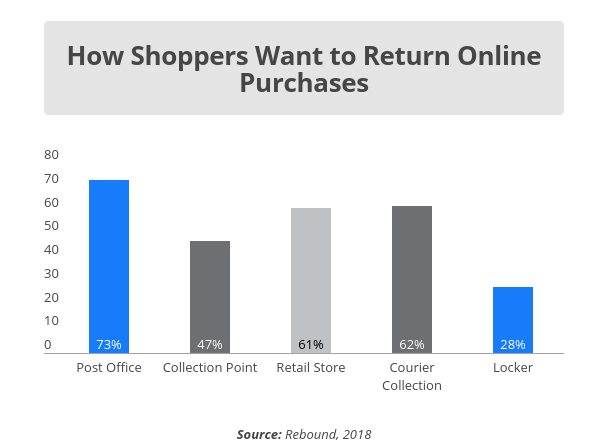Insight / Blog
Refunds and returns: How to prepare your retail business for peak returns in 2020

This year, Royal Mail predicted a staggering 80% increase in returns on the first working day of the year, with as much as 75% of purchased clothing and 42% of purchased electrical goods returned. Next year is likely to be just as intense for retailers struggling to get products back into their inventory and back onto shelves.
While 2020’s returns battle might feel far away, now is the time to prepare for retailers who want to get ahead of the competition.
This post is part of our series on eCommerce Returns. Check out our master Guide to eCommerce Returns for a full insight on how to improve your customer experience and make returns more profitable.
Policy prep
Making sure your customers are aware of your returns policy is essential – many leading retailers use their generous returns policies to increase ecommerce conversion, placing banners and clear statements in highly visible spots on homepages and product pages.
A quick checklist for your returns policy (and the marketing around it) looks like this. Is your policy:
Advertised
Simple
Competitive
Clear about refunds
If the policy is hard to find, customers will lack confidence and be less inclined to purchase. If it’s written in jargon or uses too many qualifying clauses and details, it will take too much time and effort to digest.
You also need to be matching your competitors’ offering – look at the market and see what standard offers are in your sector for a benchmark. Don’t forget that this is more like a minimum acceptable policy than necessarily a recommended approach! Being a leader in your sector for returns can give you a powerful advantage and the benefits of this should be weighed up when crafting policy.
Finally, be clear about refunds. What will you pay (cash, store credit), how will it be paid, and how soon can customers expect their money back?
Help customers find the right product first time around
Simply put, returns happen because customers think they want something which, when it arrives, is not what they want. That means the most direct remedy to prevent returns becoming an issue is to help customers get the right product first time.
There are a handful of ways to do this. Ensuring that all the product information is easily available in product pages can quickly cut returns rates. Harnessing customer data can be a powerful driver of more ‘accurate’ shopping. Retailers are adopting sizing tools like Asos’ ‘Sizing Assistant’ to generate recommendations on sizing based on a shopper’s past purchases and returns, helping customers understand which size will be right for them in a given product.
Encouraging reviews and soliciting customer feedback helps customers to see how shoppers like themselves have decided on the right product. Product feedback can also go to the right business departments in design and manufacturing, to help prevent common flaws or issues cropping up in new lines, reducing returns in the longer term.
Customers will want to return – are you making it easy for them?
The most vital part of your returns process is having the right options in place for customers to actually get their purchases back to you.

As the data show, a variety of returns options are necessary to provide customers with the most convenient option at any given time. With this in mind, you might need to consider expanding the channels you allow customers to use to return products.
This might sound like a headache, which is why technology exists to help you manage those channels and understand how your customers are behaving in the returns process. The ideal you should aim for is to provide a clear and consistent branded experience giving them updates about their return and refund. This can only be achieved with an integrated platform that monitors every touchpoint from customer hand-off to re-stocking in the warehouse or store.
That should be the goal for retailers going into 2019 peak season, letting them worry about hitting sales targets over the holiday season without worrying about the returns onslaught arriving in January.
Topics:
Related articles
How 3PLs Can Cut Costs, Reduce Waste and Boost Revenue With Smart Returns Management
3PLs should take advantage of returns to help reduce cost, efficiently manage warehouse resources, and aid growth.
Saving profits and the planet: 4 ways to sustainable & cost-effective returns
Returns drain profits and damage sustainability. Luckily, retailers can implement both cost-effective and sustainable returns using these 4 ways.
Speedy refunds: creating happy customers through fast & effective returns
Find out how speedy refunds can recapture revenue, increase customer loyalty and boost lifetime value.











